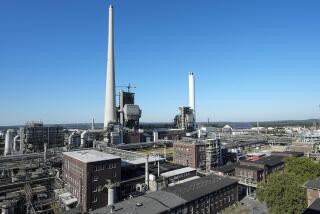Turbine Demand Driving GE Profit
- Share via
GREENVILLE, S.C. — With hundreds of natural gas-fired generating plants planned or under construction across an energy-hungry America, what business could be more promising than manufacturing the turbines to run those plants?
And with a 70% U.S. market share, what company could be more enviably positioned than General Electric Co.’s GE Power Systems division?
The Atlanta-based unit has a record $40-billion backlog of orders, including servicing contracts, stretching into 2004.
The intense demand, including recent monster orders from Calpine Corp. and Duke Energy Corp., helped drive GE’s first-quarter profit up 16% while other manufacturers struggled.
Gas-burning plants account for 90% of the generation projects in the U.S. pipeline. Called combined-cycle plants, they typically employ two gas turbines, similar to jet engines, which pressurize and superheat incoming air. Each gas turbine runs a generator directly in a first cycle, and their exhaust heats water into steam, which runs a steam turbine in the second generating cycle. The plants are highly efficient and, unlike coal and nuclear plants, can be scaled smaller or larger to fit the intended use.
Having a hammerlock on the market for so crucial a product as gas turbines might seem to be a blessing. However, the complexity and size of the machines--up to 330 tons for a turbine delivering 250 megawatts--mean that gearing up to meet soaring demand entails big risks even for a company of GE’s size and experience.
Also, some analysts believe that the power plant business could be ripe for a nasty downturn if certain bullish assumptions by plant developers aren’t met.
Although GE doubts there’s a major correction coming, it believes it is in better shape than ever to cope with one.
The key is a transformation in the way GE produces turbines, a substitution of brain for sheer financial brawn that in the last three years has enabled GE to more than triple the output of its main plant in this Piedmont city without a huge capital investment.
Gas turbine manufacturing is the fastest-growing part of a $17-billion global business that makes everything from hydroelectric equipment to nuclear generators. And Power Systems is GE’s fastest-growing division, with revenue and profit second only to GE Capital Services, the conglomerate’s gigantic finance and insurance arm.
In the mid-1990s, however, Power Systems was in a slump. The Asian financial crisis had halted many generation projects in mid-stride, and few new orders were arriving at home.
“Back in ‘97, this part of the business was on its heels,” GE spokesman Jeffrey Ignaszak said. “There were performance issues, pricing was awful, no one was buying.”
The sluggish market did have an upside, though: It gave GE the breathing space to rethink its operation, which had been dogged by quality problems.
Companywide, GE already had begun adopting the statistically oriented Six Sigma quality-improvement system pioneered by Motorola Inc. and others, and Greenville embraced it with fervor. Soon, experts in Six Sigma methods were roaming the 1.3-million-square-foot factory, collaborating with managers and line workers to come up with cost-saving and quality-enhancing refinements.
Workers realized, for example, that they could save time and add flexibility by ferrying certain smaller parts around the floor with hand carts instead of forklifts and pallets.
A more ambitious project involved hoisting each turbine to a vertical position for installation of a massive inlet valve. Computer analysis had shown that the valve could be aligned more quickly and safely by being lowered onto the turbine from above rather than pushed into place horizontally.
GE also streamlined Greenville’s operations by paring back to two the number of models produced there, shifting other work to plants in Europe.
The upshot: “In 1998, [the Greenville plant] shipped 68 units,” said Stephen B. Bransfield, a company vice president. “This quarter, we’ll ship more than we did that whole year with only a 6% increase in square footage.”
As Greenville was gearing up, GE also began exploring the implications of a steep increase in demand on its chain of outside suppliers.
A cautionary example was provided by Boeing Co., which in the mid-1990s was swamped by a flood of new aircraft orders. Overtaxed suppliers were unable to deliver parts on time, which knocked Boeing’s assembly lines out of sequence, sending overtime and other production costs into orbit. The snafus caused Boeing to incur a $2.6-billion charge against earnings in 1997, much of it due to late-delivery penalties.
Determined not to repeat the aircraft maker’s mistakes, GE enlisted its corporate audit staff to conduct a massive probe of its suppliers, sending 10-person teams of finance commandos around the globe to ride herd on suspected weak links, sometimes spending weeks at a time overseeing improvements. The mission--which was accomplished, GE says--was to eliminate potential supply “choke points” before they were exposed by a surge of new business.
GE believes that Greenville can produce its high-tech turbines at the once-unheard-of rate of 70 units per quarter--each fetching as much as $40 million--for as long as it takes to work off the backlog of orders.
But what if the problem suddenly becomes too little demand?
In a report last fall, the economic consulting firm WEFA Inc. of Eddystone, Pa., warned of a coming “financial meltdown” in the gas turbine business.
Power plant developers, WEFA said, have launched their projects based on a number of questionable assumptions, such as that the U.S. economy will avoid recession, that electricity prices will stay high, that older coal and nuclear plants will be quickly phased out and that new turbine technology will perform as well as advertised.
Kemm Farney, WEFA vice president and coauthor of the report, noted in a recent interview that the price of a 900-megawatt gas-fired generating plant designed to serve nearly 700,000 homes has ballooned to $550 million today from $425 million two years ago.
Though the price of the electricity such a plant produces has soared tenfold or more in some places, Farney said, developers are putting too much faith in their ability to capture such panic-level business.
Not only will prices fall if the economy weakens, but there also is increasing pressure on state and federal governments to restrain utility bills through price caps, Farney said. A broad lowering of prices could make many planned generating plants uneconomical and result in a glut of turbines.
And even lacking such government intervention, the markets in the long run will act, well, like markets: As more power plants go into service, especially in electricity-starved states such as California, supply-demand imbalances will dissipate and prices will inevitably stabilize.
Even if prices and demand stay strong, the report contends, new plants could face unexpected low-cost competition in the form of “stealth capacity” from existing coal, oil or nuclear plants. Operators of such facilities could decide to postpone phaseouts or even ramp up production beyond current levels, especially given the Bush administration’s intention to promote such traditional power sources under its recently issued national energy policy.
Finally, if the turbines being built perform more poorly than expected--with more downtime or higher pollution levels--that too would undercut the assumptions on which some projects were founded, WEFA said.
Ignaszak of GE said that, far from being untested, his company’s best-selling line of new turbines already has logged 4 million hours of operating experience with a high degree of reliability.
With about 200 turbines on order from GE and competitor Siemens/Westinghouse, Calpine of San Jose is making what may be history’s biggest bet on new power generation.
“Gas turbines are not unlike any other technological advance--early models will have their challenges,” Jake Rudisill, Calpine’s senior vice president for the Western region, said in a recent interview. But of the turbines now running in Calpine plants, “we’ve experienced nothing outside the [performance] bounds we’ve set,” he added.
As for demand, Calpine’s strategy is to be the low-cost leader in producing gas-fired power, spokeswoman Katherine Potter said. Its new, highly efficient plants should be able to operate more cheaply than any gas competitors. Coal-fired plants, though more costly to build, are generally cheaper to operate, so Calpine avoids competing against them head-on, Potter said.
Just as big a factor as the final price of electricity is the price of a gas plant’s major variable cost: the natural gas. Amy Jaffe, senior energy advisor at Rice University in Houston, said many gas plants can operate profitably with the fuel at $5.50 per million British thermal units.
“You have to believe natural gas is going to $6 to $10 to believe people are going to cancel these turbine orders,” she said.
But in all likelihood, with the Bush administration pushing for new gas exploration and with huge new fields recently discovered in the Rocky Mountains, long-term prices are headed lower, not higher, Jaffe said.
Indeed, national prices that spiked above $10 per million BTU in December have dropped below $4.
“If I had a turbine on order, I wouldn’t cancel it so fast,” Jaffe said, adding: “GE might have a bumpy year, but it won’t have a bumpy five years.”
More to Read
Inside the business of entertainment
The Wide Shot brings you news, analysis and insights on everything from streaming wars to production — and what it all means for the future.
You may occasionally receive promotional content from the Los Angeles Times.










